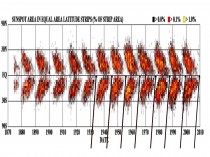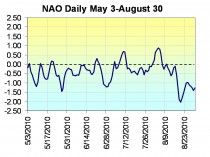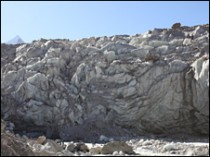Sep 01, 2010
Covering up for George Soros
By Ed Lasky
The sinister, omnipresent moneybags of the American left, George Soros, knows that distraction and misdirection make for a good defense. So do his many lackeys and sympathizers in the American media.

Recently, the left has built up two conservative billionaire brothers as their latest bogeymen. I am referring to the libertarians Charles and David Koch, who fund, among other groups, Americans for Prosperity. First Barack Obama lambasted them, and his minions in the media dutifully followed. Jane Mayer’s 10,000-word article in the New Yorker, titled “Covert Operations: the billionaire brothers who are waging a war against Obama,” has been widely cited in other liberal media.
In reality, the brothers have long funded a variety of causes years before anyone had ever heard of Obama. Regardless, Mayer’s article was criticized as shameful by others, including a trenchant bit of criticism by Mark Hemingway in the Washington Examiner. One of Hemingway’s points was right on target: Mayer’s barely visible coverage of George Soros, sugar daddy of the Democratic Party and an early, ardent and generous supporter of Barack Obama. Hemingway excerpts a paragraph from Mayer’s article and notes some omissions:
But this passage from Mayer’s piece is also worth noting, as a measure of the article’s bias:
Of course, Democrats give money, too. Their most prominent donor, the financier George Soros, runs a foundation, the Open Society Institute, that has spent as much as a hundred million dollars a year in America. Soros has also made generous private contributions to various Democratic campaigns, including Obama’s. But Michael Vachon, his spokesman, argued that Soros’s giving is transparent, and that “none of his contributions are in the service of his own economic interests.”
The idea that Soros’ giving is transparent is laughable—he’s given millions to the Tides Foundation, a byzantine organization notorious for obscuring finding sources on the left ... Further, Soros was very influential in setting up the Center for American Progress think tank and many other liberal organizations in the last decade. If any billionaire has waged war against a president recently, it’s Soros’ campaign against Bush. To dismiss any concerns about Soros’ political spending while saying that the Koch brothers are at the center of a dark conspiracy is absurd.
Mayer just let the claim that Soros has no monetary interest when he gives money stand unchallenged—and that was shameful. Where was the famed New Yorker fact-checking department? Did they get laid off?
Let me expand on Hemingway’s commentary, in light of the view that somehow Soros’s giving has zero to do with his financial interest—or, as his spokesman spins, “none of the contributions are in the service of his economic interests.” New York Times theatre critic turned frothing attack dog columnist of the left Frank Rich has started promoting this theme: Soros is Santa Claus or Mother Theresa. This Sunday, Rich had his typical invective-filled column—also railing against the Kochs—and then gave us this whopper:
Soros is a publicity hound who is transparent about where he shovels his money and “like many liberals—selflessly or foolishly, depending on your point of view—he supports causes that are unrelated to his business interests.”
What planet do Mayer and Rich live on? Soros obviously has his financial interests in mind when he gives, and he knows how to use his billions to make more billions by tapping his friends in high places in the Democratic Party.
For example, Soros has made a boatload of money off his huge investment in the Brazilian oil company, Petrobras, a company that has benefited mightily from its deep offshore oil reserves. Barack Obama had the U.S. Export-Import bank extend billions of dollars of loans to underwrite Petrobras’s offshore oil development. Soros positioned himself to reap big gains just days before his pal in the White House pushed for billions in loans to Petrobras—a company from a country that can certainly tap the financial markets on its own to raise funds to tap oil off its shores. The company did not need easy money from American taxpayers. Yet there was Soros, who somehow was prescient enough to roll the loaded dice in taking a major stake in Petorbras. He got a double-dip type of return when Barack ("never let a crisis go to waste") Obama shut down deep-water oil exploration off America’s own energy-rich coasts—further enriching the prospects for Petrobras and George Soros.
Strike one.
Soros’s pet think-tank, the Center for American Progress, constantly pushes green schemes. Democratic politicians are on board, as well. This group includes Barack Obama who, runs after one electric battery, solar power plant, and windmill after another (when he is not on the links or listening to live music at the club he created in the East Room of the White House). How generous have Obama and the Democrats been to the green schemers? The grand champion of budget-busting departments has been the “Energy Efficiency and Renewable Program,” which received $1.7 billion in 2008 and $16.8 billion in 2009, a 1,014% increase in just one year. Media reports over the past year or so have tied numerous Democratic donors to these “ventures.” They have been richly rewarded with taxpayer dollars.
What a great scheme! Give thousands to Obama and various Democrats and get billions back in our taxpayer dollars. Who is a big investor in “clean energy,” by the way? Why, none other than George Soros, who announced back in October 2009 that he would invest at least $1 billion in “clean energy.” The Center for American Progress is closely tied to the Obama administration (see “Soros-Funded Democratic Idea Factory Becomes Obama Policy Font") and serves as its hiring hall, not to mention as the fourth or fifth branch of government (or so it seems—I have the Center for American Progress as a Google search term, and the employees of that tank are all over the media landscape, as well as D.C.). Soros knows how to use leverage, and the millions he put into the Center for American Progress (and into the election of Barack Obama and other leftist Democrats) will reap big returns—at our expense—in the years ahead.
Strike two.
Whatever happened to all the hullaballoo regarding hedge funds? Back in 2008 and early 2009, Democrats were busy blaming Wall Street, hedge funds, and Republicans for the financial crisis. We were promised that hedge funds would be regulated to the point of harmlessness, that their investors would have to be disclosed, their positions monitored, their leverage controlled. What happened to those promises? Well, that did not suit hedge fund managers—not at all. So the promises went away.
And who was one of the biggest hedge fund titans out there? Why, it happens to be none other than George Soros, who made billions in 2008 from the financial and housing collapse and then made billions more in 2009 as the Democrats bailed out Wall Street. Who was the major beneficiary of hedge fund campaign money in 2008? Barack Obama, eclipsing the long-time champ in this area, Christopher Dodd, the Senator from Connecticut (Hedgefundland) who chaired the Senate Banking Committee. In 2008, I noted that Obama was “The Hedge Fund Candidate.”
Obama, Dodd, and fellow Democrats just forgot that crusade against hedge funds, and Soros continues to rake in billions. George Soros—who is the number-one funder of so-called 527 groups (such as MoveOn.Org)—gets his money’s worth whenever and wherever he puts it to work. He finds his best leverage in the Democratic Party.
Strike three.
And a bonus pitch.
I have written quite a bit about the riches we have in America in the form of shale gas. Soros has investments in the energy industry that would be harmed if our cheap and plentiful reserves were tapped to their full extent. Among his holdings are a huge one in InterOil that has big reserves of natural gas in New Guinea. Democrats are now trying to shut down our shale gas industry by attacking “fracking”—a method that is used to extract the gas from the shale rock that holds it. There is plenty of evidence that fracking is safe and sound—it has been used for many years. Nevertheless, the industry is under attack by Democrats in Congress such as Ed Markey, by Obama’s EPA, by the Center for American Progress, by Pro Publica—an outfit created and funded by Soros pals Herbert and Marion Sandler—and recently by MoveOn.org. Soros must be getting desperate, as Americans crave cheap natural gas, to bring in MoveOn.org, which has heretofore focused on the purely political sport of bashing Republicans and electing as many left-wingers as it could—including, of course, the biggest of them all, Barack Obama.
One could go on. Soros is an enterprising man and legendary investor. He figured out sooner and better than anyone else how to buy political power and bend politicians to his will. He is not a goody-two-shoes, as partisans on the left try to portray him. He has benefited hugely from leverage, and the best leverage he enjoys is when he “gives” money in ways that are really investments (payoffs, bribes?) in disguise. Shame on Mayer, Rich, and others who hide this history. They also are all but puppets in the hands of George Soros. Post is here.
Ed Lasky is news editor of American Thinker
Sep 01, 2010
Johnson’s stance is the correct one
Letter to the Milwaukee Journal Sentinel Online
As scientists, we write to support U.S. Senate candidate Ron Johnson’s correct view on natural factors of climate change as reported in the Journal Sentinel (Page 1B, Aug. 17; Page 1A, Aug. 21).
This is not a debate about politics or about a belief system. Objective science informs us that the so-called consensus viewpoints offered by the United Nations Intergovernmental Panel on Climate Change about man-made carbon dioxide being the dominant factor of climate change is largely a political conclusion and not likely a scientifically correct one.
If global temperatures are supposedly affected by rapidly rising atmospheric CO2 concentrations but the warming has ceased over at least the last decade, then something more important than atmospheric CO2 must be driving climate change. This is why the National Oceanic and Atmospheric Administration reported Aug. 13 that “greenhouse gas forcing fails to explain the 2010 heat wave over western Russia.”
We wish to emphasize that many peer-reviewed publications exist that support the minimal role of atmospheric CO2 as a cause for the weather and climate that we experience. Extremist views only serve to induce panic about climate change, and the unwillingness to address the real science only leads to spurious claims that “the science is settled.”
For example, a paper published Aug. 19 in Geophysical Research Letters by a scientist from the California Institute of Technology shows that even the apparently drastic decrease of summer-autumn Arctic sea ice is not unprecedented but merely an effect of Arctic Ocean geography.
We therefore applaud Senate candidate Ron Johnson’s stance against CO2-induced climate change.
Eight scientists signed this letter; they noted that their university affiliations are for identification purposes only and are not an endorsement of the letter. The signers are: Willie Soon, Harvard-Smithsonian Center for Astrophysics; Scott Armstrong, Wharton School at University of Pennsylvania; Robert Carter, James Cook University, Australia; Susan Crockford, University of Victoria, Canada; Kesten Green, University of South Australia; Nils-Axel Morner, Stockholm University, Sweden; George Taylor, Oregon State University, retired; and Mitchell Taylor, Lakehead University, Canada.
Aug 31, 2010
How Harvard’s Code of Ethics Differs from UVA and Penn State with respect to Michael Mann
By Charles Battig, MD
An insight into the apparent difference in how “scientific misconduct” at Harvard University is handled, and how it has been handled at Penn State and the University of Virginia in the matter of climatologist Michael Mann is now available.
Harvard professor of psychology Marc Hauser was found “solely responsible for eight instances of scientific misconduct” involving the “data acquisition, data analysis, data retention, and the reporting of research methodologies and results” according to the August 20, 2010 statement by Harvard dean Michael D. Smith. This finding was issued based on a faculty investigating committee study. The report noted that it began with an “inquiry phase” in response to “allegations of scientific misconduct.” It seems that there were allegations of “monkey business” in his research on monkey cognition. Three papers by Hauser, presumably peer reviewed, will need to be corrected or retracted according to Dean Smith. The academic fate of the professor is yet to be decided.
In contrast, the two reviews of the behavior of climatologist Michael Mann at Penn State seemed primarily focused on his data housekeeping habits and openness to sharing his data and analysis methodology. He was found to have acted within the ‘accepted practices within the scientific community for proposing, conducting, or reporting research.” The issues of data acquisition and analysis validity were not pursued; the number of awards and publications Mann received was cited as evidence of the validity of his work.
At the University of Virginia an “inquiry phase”, such as noted in the Harvard protocol, was initiated by Virginia Attorney General Ken Cuccinelli into the possible misuse of public funds by Mann in his pursuit of employment by the University and his use of such funds in his research activities there. Virginia state law gives wide discretion to the AG in the initiation of investigations into suspected misuse of state funds. This request was met with claims of impingement on sacred academic freedom, and chilling the environment for academic research in general by the university and its various supporters. Rather than welcome the chance to dispel the suspicion of scientific misconduct and protect its academic reputation, the university enlisted a high powered D.C. legal team to fight the AG request in court.
While this legal process plays out, the court of public opinion must wonder why the openness and direct dealing with such allegations exhibited by Harvard is not the model for the University of Virginia. Harvard is shown to be a scientifically open and self policing university; UVa is hiding behind its self -righteous claims of academic freedom and legal barricades. Whose research will the public more likely trust?
Charles Battig, M.D.
President, Piedmont Chapter
Virginia Scientists and Engineers for Energy and Environment
Charlottesville, VA
Aug 31, 2010
11 Year Cycle in Hot Summers
By Joseph S. D’Aleo, CCM
We have seen hot summers in 1933, 1944, 1955, 1966, 1977, 1988, 1999, 2010. Notice a pattern? The years are 11 years apart.
This 11 year cycle may be a coincidence but if so a 1 in 256 chance one. In some years the heat was concentrated in one month (1966 it was July), in others it was throughout.
What else has an 11 year cycle? - the sun of course. The solar cycles average 11 years. When new solar cycles begin the new spots are in higher solar latitudes and gradually move equatorward. During transitions you typically have old cycle spots near the equator and new cycle spots at higher latitudes.
The 11 years above have been during these transitions. A coincidence? We’ll leave it to our solar expert readers to speculate whether this is solar driven and possible mechanisms. Other common elements in some of the years include an El Nino winter giving way to a La Nina summer and strong rebound from a very negative winter negative Arctic Oscillation (AO) pattern.

See so-called butterfly diagram with positions of sunspots by year enlarged here.
Compositing those years gives you this warm summer signal.

See enlarged here.
The actual anomalies through August 30 showed the warmth further south. This may be because of a continuation of strong high latitude blocking (negative NAO) as evidenced by the warmth in northeast Canada.

See enlarged here.
Indeed a plot of the daily NAO as obtained from NOAA CPC shows a predominant negative NAO. This forces everything else further south in North America and the Atlantic.

See enlarged here.
In July, a negative NAO means a hot southeast. By winter, it means cold.
A continuation of this blocking may make the upcoming La Nina winter more interesting. The winters tend to be cold in the west and north, warmer in the southeast. See more here.
Aug 30, 2010
Himalayan glaciers melting deadline ‘a mistake’
By Pallava Bagla in Delhi
The UN panel on climate change warning that Himalayan glaciers could melt to a fifth of current levels by 2035 is wildly inaccurate, an academic says.
J Graham Cogley, a professor at Ontario Trent University, says he believes the UN authors got the date from an earlier report wrong by more than 300 years.
He is astonished they “misread 2350 as 2035”. The authors deny the claims.
Leading glaciologists say the report has caused confusion and “a catalogue of errors in Himalayan glaciology”.
The Himalayas hold the planet’s largest body of ice outside the polar caps - an estimated 12,000 cubic kilometres of water.
They feed many of the world’s great rivers - the Ganges, the Indus, the Brahmaputra - on which hundreds of millions of people depend.
‘Catastrophic rate’
In its 2007 report, the Nobel Prize-winning Inter-governmental Panel on Climate Change (IPCC) said: “Glaciers in the Himalayas are receding faster than in any other part of the world and, if the present rate continues, the likelihood of them disappearing by the year 2035 and perhaps sooner is very high if the Earth keeps warming at the current rate.

It is not plausible that Himalayan glaciers are disappearing completely within the next few decades
Himalayan glaciers’ ‘mixed picture’
“Its total area will likely shrink from the present 500,000 to 100,000 square kilometres by the year 2035,” the report said.
It suggested three quarters of a billion people who depend on glacier melt for water supplies in Asia could be affected.
But Professor Cogley has found a 1996 document by a leading hydrologist, VM Kotlyakov, that mentions 2350 as the year by which there will be massive and precipitate melting of glaciers.
“The extrapolar glaciation of the Earth will be decaying at rapid, catastrophic rates - its total area will shrink from 500,000 to 100,000 square kilometres by the year 2350,” Mr Kotlyakov’s report said.
Mr Cogley says it is astonishing that none of the 10 authors of the 2007 IPCC report could spot the error and “misread 2350 as 2035”.
“I do suggest that the glaciological community might consider advising the IPCC about ways to avoid such egregious errors as the 2035 versus 2350 confusion in the future,” says Mr Cogley.
He said the error might also have its origins in a 1999 news report on retreating glaciers in the New Scientist magazine.
The article quoted Syed I Hasnain, the then chairman of the International Commission for Snow and Ice’s (ICSI) Working group on Himalayan glaciology, as saying that most glaciers in the Himalayan region “will vanish within 40 years as a result of global warming”.
Scientists say Himalayan glaciers need more study
When asked how this “error” could have happened, RK Pachauri, the Indian scientist who heads the IPCC, said: “I don’t have anything to add on glaciers.”
The IPCC relied on three documents to arrive at 2035 as the “outer year” for shrinkage of glaciers.
They are: a 2005 World Wide Fund for Nature report on glaciers; a 1996 Unesco document on hydrology; and a 1999 news report in New Scientist.
Incidentally, none of these documents have been reviewed by peer professionals, which is what the IPCC is mandated to be doing.
Murari Lal, a climate expert who was one of the leading authors of the 2007 IPCC report, denied it had its facts wrong about melting Himalayan glaciers.
But he admitted the report relied on non-peer reviewed - or ‘unpublished’ - documents when assessing the status of the glaciers.
‘Alarmist’
Recently India’s Environment Minister Jairam Ramesh released a study on Himalayan glaciers that suggested that they may be not melting as much due to global warming as it is widely feared.
He accused the IPCC of being “alarmist”.
India says the rate of retreat in many glaciers has decreased in recent years
Mr Pachauri dismissed the study as “voodoo science” and said the IPCC was a “sober body” whose work was verified by governments.
But in a joint statement some the world’s leading glaciologists who are also participants to the IPCC have said: “This catalogue of errors in Himalayan glaciology… has caused much confusion that could have been avoided had the norms of scientific publication, including peer review and concentration upon peer-reviewed work, been respected.”
Michael Zemp from the World Glacier Monitoring Service in Zurich also said the IPCC statement on Himalayan glaciers had caused “some major confusion in the media”.
“Under strict consideration of the IPCC rules, it should actually not have been published as it is not based on a sound scientific reference.
“From a present state of knowledge it is not plausible that Himalayan glaciers are disappearing completely within the next few decades. I do not know of any scientific study that does support a complete vanishing of glaciers in the Himalayas within this century.”
Pallava Bagla is science editor for New Delhi Television (NDTV) and author of Destination Moon - India’s quest for Moon, Mars and Beyond.
|








